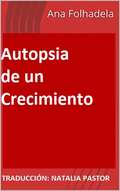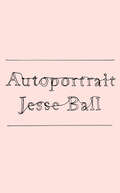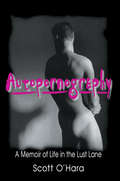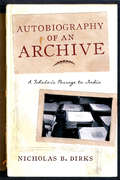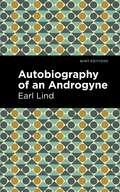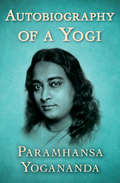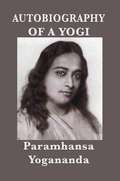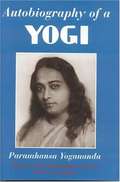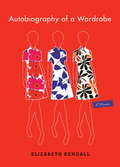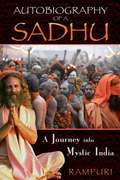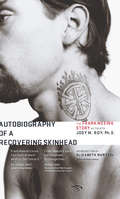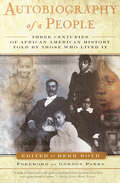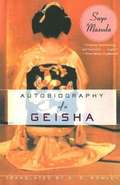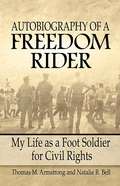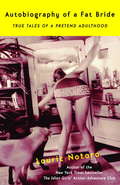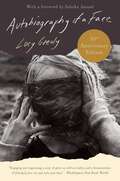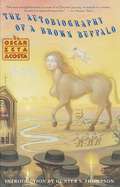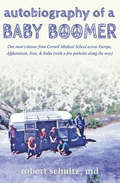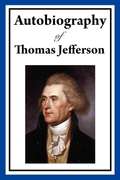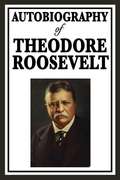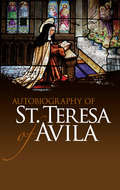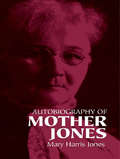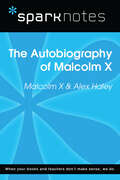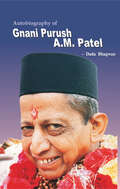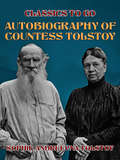- Table View
- List View
Autopsia de un Crecimiento
by Ana FolhadelaLibro de reflexiones, dedicado a la memoria de mis padres. Luchando con el otro infierno que está dentro de cada uno de nosotros. El bicho hombre es un ser doble en el cual uno de los dos lados se divierte atormentando y el otro pasa todo el tiempo defendiéndose, mientras el tiempo discretamente pasa y los evita a ambos. Pero es más complicado dejar de oirse cuando nos comprendemos. Es complicado intentar convencer a una persona de que está errada cuando quien la convence siente que la otra tiene razón. Es complicado creer que eso cambiará el mundo cuando se cree que el mundo apenas nos quiere engañar para normalizarnos. Porque si ese mundo fuera para adelante y el otro, que está adelante, fuera para atrás, perdemos por eso la fuerza de empuje de lo que está más adelante para avanzar más, porque ese es nuestro deber como persona, independientemente de ser lo mejor o lo más provechoso para nosotros, estaremos haciéndole mal al mundo. Estaremos cayendo en la apatía. Dejaremos de ser nosotros. Si siempre nos conocemos así ¿cómo vamos a coseguir vivir como una persona que no somos, pero que conoce todo el bien y el mal en nosotros? Desilusionarnos y dejar de vivir antes de la muerte. Manifestar aquello en lo que creemos. Vender nuestra alma al infierno de los otros. Es tiempo de reunirse en casa y cerrar los ojos, de modo que la oscuridad nos envuelva por completo. Es tiempo de dejar que el silencio diga lo que es mejor para nosotros. Es tiempo de respetar y hacer respetar la esencia de lo que somos. Si agrada o no, es lo que tenemos y no se puede exigir a una persona dar aquello que tiene. Si damos lo que tenemos para el bien del mundo, ¿qué importa lo que el mundo piense de nosotros, lo que piense el infieno que son los otros?
Autoportrait
by Jesse BallA work of unflinching honesty, Autoportrait is a hypnotic memoir of reflection, loss, and everyday joy from one of America's best contemporary novelistsJesse Ball has produced fourteen acclaimed works of deeply empathetic absurdism in poetry and fiction. Now, he offers readers his first memoir, one that showcases his &“humane curiosity&” (James Wood) and invites the reader into a raw and personal account of love, grief, and memory. Inspired by the memoir Édouard Levé put to paper shortly before his death, Autoportrait is an extraordinarily frank and intimate work from one of America's most brilliant young authors.The subtle power of Ball's voice conjures the richness of everyday life. On each page, half-remembered moments are woven together with the joys and triumphs—and the mistakes and humiliations, too—that somehow tell us who we are, why we are here. Held at the same height as tragic accounts of illness or death are moments of startling beauty, banality, or humor: "I wake in the morning, I sit, I walk long distances. If there is somewhere to swim, I may swim. If I have a bicycle, I will ride it, especially to meet someone. There is no more preparing for me to do, other than preparing for death, and I do that by laughing. Not laughing at death, of course. Laughing at myself." An extraordinary memoir that reminds us what is possible and builds to the kind of power one might feel reading Anne Carson's Glass Essay, or Joe Brainard's I Remember. Autoportrait will leave you feeling utterly invigorated, inspired, and a little afraid.
Autopornography: A Memoir of Life in the Lust Lane
by Scott O' HaraIn this provocative book, retired porn star Scott O’Hara (known as “Spunk” by many of his fans from an early punk photospread) gives a backstage look at the world of pornography, revealing why he loved it, what he got out of it, and why he left it. In an autobiographical style, he considers and poses answers to some fascinating questions: What is sex? What makes a porn star? And why does pornography really upset people? You’ll really get to know this noted gay porn star as you get a firsthand look at his life experiences and sexual journeys from his boyhood days of locker room fantasies and sexual experimentation to his years as a porn star and then to his experiences as an individual facing the realities of being HIV-positive. As O’Hara puts it in his Introduction: “This book was written as a last-ditch effort: a way to open up all my closets, let you in on all the dark corners of my life, and give you a better picture of what goes into the making of a porn star. Because if there’s one profession that arouses people’s curiosity, it’s that one.” As you read through the pages of Autopornography, you’ll see how O’Hara’s personality reflects his sexuality, that is, how they have melded into one. His vivid descriptions of personal relationships (with family, friends, lovers, and casual acquaintances) and his many sexual encounters as he traveled the world reveal his love of sex and his desire to live without inhibitions, secrets, or sexual constraints. Reading Autopornography may cause you to reexamine your own sexual boundaries, realize new sexual potential, and discover sexual desires not previously aroused.Listed #14 on Books Bought Mainly by Men 1997 Top 100 Bestsellers as rated by A Different Light Bookstore!
Autobiography of an Archive: A Scholar's Passage to India (Cultures of History)
by Nicholas DirksThe decades between 1970 and the end of the twentieth century saw the disciplines of history and anthropology draw closer together, with historians paying more attention to social and cultural factors and the significance of everyday experience in the study of the past. The people, rather than elite actors, became the focus of their inquiry, and anthropological insights into agriculture, kinship, ritual, and folk customs enabled historians to develop richer and more representative narratives. The intersection of these two disciplines also helped scholars reframe the legacies of empire and the roots of colonial knowledge. <P><P>In this collection of essays and lectures, history's turn from high politics and formal intellectual history toward ordinary lives and cultural rhythms is vividly reflected in a scholar's intellectual journey to India. Nicholas B. Dirks recounts his early study of kingship in India, the rise of the caste system, the emergence of English imperial interest in controlling markets and India's political regimes, and the development of a crisis in sovereignty that led to an extraordinary nationalist struggle. He shares his personal encounters with archives that provided the sources and boundaries for research on these subjects, ultimately revealing the limits of colonial knowledge and single disciplinary perspectives. Drawing parallels to the way American universities balance the liberal arts and specialized research today, Dirks, who has occupied senior administrative positions and now leads the University of California at Berkeley, encourages scholars to continue to apply multiple approaches to their research and build a more global and ethical archive.
Autobiography of an Androgyne
by Earl LindAutobiography of an Androgyne (1918) is an autobiography by Earl Lind. Accompanied by an introduction by Dr. Alfred W. Herzog, Lind’s autobiography―intended for a clinical audience―has been recognized as a pioneering work in the history of transgender literature. Throughout his life, Lind was forced to justify and defend his existence from puritanical authorities who refused to even recognize the reality of his identity as an androgyne. In the first of his trilogy of autobiographical works, he not only demands recognition, but exposes the denial of his existence as nothing but hatred and fear. “Androgynes have of course existed in all ages of history and among all races. In Greek and Latin authors there are many references to them, but these references are not always understood except by the few scholars who are themselves androgynes or at least passive sexual inverts. […] [T]hese men-women, because misunderstood, have been held in great abomination both in the middle ages and in modern times, but the prejudice against them was not so extreme in antiquity, and a cultured citizen having this nature did not then lose caste on this account.” Situating his own identity within this history of oppression, Lind makes the case for recognizing the presence of androgynes in all human societies. Ever since he was a child, Lind identified as feminine and was keenly aware of his homosexual desires, gaining a reputation among the local boys and soon turning to girls for friendship and understanding. In a world that saw androgynes as both corrupt and willfully different, Lind sought to increase understanding and to explain through scientific, historical, and personal evidence why his identity was congenital, and therefore natural. With a beautifully designed cover and professionally typeset manuscript, this edition of Earl Lind’s Autobiography of an Androgyne is a classic work of transgender literature reimagined for modern readers.
Autobiography of a Yogi: Reprint Of The Philosophical Library 1946 First Edition
by Paramhansa YoganandaThe spiritual journey of the man who introduced yoga to the West, and inspired practitioners from George Harrison to Steve Jobs. The remarkable life story of Paramhansa Yogananda is the groundbreaking work that introduced millions of Westerners to the practices of meditation and Kriya Yoga. Yogananda tells of his childhood in Gorakhpur, India, with his Bengali family, and his quest to find a guru who could satiate his desire for wisdom. After becoming a monk, he began his teachings of Kriya Yoga. But when he accepted an invitation to speak at a religious congress in Boston in 1920, his knowledge found an entirely new audience, as he then traveled across America lecturing and finally establishing the Self-Realization Fellowship in Los Angeles, where he was able to complete this classic work of spiritual expression. Autobiography of a Yogi has been in print for over seventy years, sold over four million copies, and been translated into forty-six languages, spreading the wisdom of one of the most highly revered teachers of the Hindu religion and philosophy. This ebook has been professionally proofread to ensure accuracy and readability on all devices.
Autobiography of a Yogi: (With Pictures)
by Paramhansa YoganandaOne of the Top 100 Spiritual Books of the Twentieth CenturyNew Bonus Materials added to this edition include The last chapter that Yogananda wrote covering the years 1946-1951 that wasnot available in the original edition. The eulogy that Yogananda wrote for Gandhi. A new afterword by Swami Kriyananda, one of Yogananda's closest disciples.This is a new edition, featuring previously unavailable material, of true spiritualclassic, Autobiography of a Yogi one of the best-selling eastern philosophytitles of all-time, with millions of copies sold, named one of the best and mostinfluential books of the 20th century.This highly prized verbatim reprinting of the original 1946 edition is theONLY one available free from textual changes made after Yoganandas death.This updated edition contains bonus materials, including a last chapter thatYogananda himself wrote in 1951, five years after the publication of the firstedition. It is the only version of this chapter available without posthumouschanges.Yogananda was the first yoga master of India whose mission it was to liveand teach in the West. His first-hand account of his life experiences includes childhoodrevelations, stories of his visits to saints and masters in India, and long-secretteachings of Self-realization that he made available to the Western reader.
Autobiography of a Yogi
by Paramhansa YoganandaThroughout the decades, one title that continues to appear on best-seller lists is Paramahansa Yogananda's Autobiography of a Yogi. This timeless book remains a seminal work in the field of Eastern religion -- the definitive introduction to the science and philosophy of yoga meditation that draws more readers with each passing year. All our editions of the Autobiography include extensive material added by the author after the first edition was published, including a final chapter on the closing years of his life. Also included are numerous high-quality photographs and a complete subject index.
Autobiography of a Wardrobe
by Elizabeth KendallSaddle shoes. Camp shorts. Girdles. Bell-bottoms. Each plays a significant role as we follow B., the wardrobe's owner, through her buttoned-up Midwestern childhood to the freedom of miniskirts, sundresses, and New York City. We watch as B. copes with the untimely death of her mother, makes a go of glamorous magazine work, and, after the inevitable false starts and fashion missteps, finally comes into her own.Part memoir, part fashion and cultural history of the last five decades, Autobiography of a Wardrobe is an exploration of the clothes each generation has embraced and the smallest details in which we are able to seek comfort and meaning.From the Trade Paperback edition.rk; and, after the inevitable false starts and wrong moves (including, of course, in her choice of clothing), finally comes into her own.Part memoir, part fashion and cultural history of the last five decades, Autobiography of a Wardrobe is an exploration of the clothes each generation has embraced, the smallest details in which we are able to seek comfort and meaning, and the places and things--sometimes odd or unexpected--in which we store our memories.From the Hardcover edition.
Autobiography of a Sadhu: A Journey into Mystic India
by RampuriThe first insider account of an ancient and secretive tradition • By the first foreigner to become a member, and later an elder, of the Juna Akhara, the oldest and largest grouping of Naga Babas • Filled with true accounts of magic, miracles, ghosts, and austerities • With lessons on Hindu gods, ayurveda, and Indian culture woven throughout After traveling at age 18 from his native California to India in 1969, Rampuri was drawn to the Naga Babas, an ancient and wild order of naked yogis whom he calls the “Hell’s Angels of Indian Spirituality.” Organized into a sect by Adi Shankara in the 5th century BC, the Naga Babas see themselves as the ultimate protectors of the Sanatan Dharma, or what we call the Hindu religion. Rampuri became a disciple of a Naga Baba--a master shaman sadhu--from Rajasthan and, as foretold by astrological prophecy, soon found himself the first foreigner to become an initiate of the Juna Akhara, the oldest and largest grouping of Naga Babas with more than 50,000 sadhu members. From drinking the “Nectar of Immortality” at the source of the Ganges River to allegations of tantric murder, this autobiography is filled with true accounts of magic, miracles, ghosts, and austerities, with lessons on Hindu gods, ayurveda, mantra, and Indian culture woven throughout. Through his journey of extremes, Rampuri takes us into the mystic heart of India.
Autobiography of a Recovering Skinhead
by Elizabeth Wurtzel Jody M. Roy Frank MeeinkAutobiography of a Recovering Skinhead is Frank Meeink's raw telling of his descent into America's Nazi underground and his ultimate triumph over drugs and hatred. Frank's violent childhood in South Philadelphia primed him to hate, while addiction made him easy prey for a small group of skinhead gang recruiters. By 16 he had become one of the most notorious skinhead gang leaders on the East Coast and by 18 he was doing hard time. Teamed up with African-American players in a prison football league, Frank learned to question his hatred, and after being paroled he defected from the white supremacy movement and began speaking on behalf of the Anti-Defamation League. A story of fighting the demons of hatred and addiction, Frank's downfall and ultimate redemption has the power to open hearts and change lives.
Autobiography of a People: Three Centuries of African American History Told by Those Who Lived It
by Herb BoydAutobiography of a People is an insightfully assembled anthology of eyewitness accounts that traces the history of the African American experience. From the Middle Passage to the Million Man March, editor Herb Boyd has culled a diverse range of voices, both famous and ordinary, to creat a unique and compelling historical portrait:Benjamin Banneker on Thomas JeffersonOld Elizabeth on spreading the Word Frederick Douglass on life in the North W.E.B. Du Bois on the Talented Tenth Matthew Henson on reaching the North Pole Harriot Jacobs on running awayJames Cameron on escaping a mob lynichingAlvin Ailey on the world of danceLangston Hughes on the Harlem Renaissance Curtis Morriw on the Korean WarMax ROach on "jazz" as a four-letter wordLL Cool J on rapMary Church Terrell on the Chicago World's FairRev. Bernice King on the future of Black AmericaAnd many others.From the Trade Paperback edition.
Autobiography of a Geisha
by G. G. Rowley Sayo MasudaSayo Masuda was a geisha at a hot springs resort, where the realities of sex for sale are unadorned by the trappings of wealth and power. Remarkable for its wit and frankness, the book is a moving record of a woman's survival on the margins of Japanese society -- in the words of the translator, "the superbly told tale of a woman whom fortune never favored yet never defeated."
Autobiography of a Freedom Rider: My Life as a Foot Soldier for Civil Rights
by Thomas Armstrong Natalie BellIn the segregated Deep South when lynching and Klansmen and Jim Crow laws ruled, there stood a line of foot soldiers ready to sacrifice their lives for the right to vote, to enter rooms marked "White Only," and to live with simple dignity. They were called Freedom Riders and Thomas M. Armstrong was one of them. This is his story as well as a look ahead at the work still to be done. June, 1961. Thomas M. Armstrong, determined to challenge segregated interstate bus travel in Mississippi, courageously walks into a Trailways bus station waiting room in Jackson. He is promptly arrested for his part in a strategic plan to gain national attention. The crime? Daring to share breathing space marked "Whites Only." Being of African-American descent in the Mississippi Deep South was literally a crime if you overstepped legal or even unspoken cultural bounds in 1961. The consequences of defying entrenched societal codes could result in brutal beatings, displacement, even murder with no recourse for justice in a corrupt political machine, thick with the grease of racial bias. The Freedom Rides were carefully orchestrated and included both black-and-white patriots devoted to the cause of de-segregation. Autobiography of a Freedom Rider details the strategies employed behind the scenes that resulted in a national spectacle of violence so stunning in Alabama and Mississippi that Robert Kennedy called in Federal marshals. Armstrong's burning need to create social change for his fellow black citizens provides the backdrop of this richly woven memoir that traces back to his great-grandparents as freed slaves, examines the history of the Civil Rights Movement, the devastating personal repercussions Armstrong endured for being a champion of those rights, the sweet taste of progressive advancement in the past 50 years, and a look ahead at the work still to be done. Hundreds were arrested for their part in the Freedom Rides, Thomas M. Armstrong amongst them. But it is the authors' quest to give homage to "the true heroes of the civil rights movement . . . the everyday black Southerners who confronted the laws of segregation under which they lived . . . the tens of thousands of us who took a chance with our lives when we decided that no longer would we accept the legacy of exclusion that had robbed our ancestors of hope and faith in a just society."
Autobiography of a Fat Bride: True Tales of a Pretend Adulthood
by Laurie NotaroThe author of the New York Times bestseller The Idiot Girls' Action-Adventure Club tackles her biggest challenge yet: grown-up life.<P><P> In Autobiography of a Fat Bride, Laurie Notaro tries painfully to make the transition from all-night partyer and bar-stool regular to mortgagee with plumbing problems and no air-conditioning. Laurie finds grown-up life just as harrowing as her reckless youth, as she meets Mr. Right, moves in, settles down, and crosses the toe-stubbing threshold of matrimony. From her mother's grade-school warning to avoid kids in tie-dyed shirts because their hippie parents spent their food money on drugs and art supplies; to her night-before-the-wedding panic over whether her religion is the one where you step on the glass; to her unfortunate overpreparation for the mandatory drug-screening urine test at work; to her audition as a Playboy centerfold as research for a newspaper story, Autobiography of a Fat Bride has the same zits-and-all candor and outrageous humor that made Idiot Girls an instant cult phenomenon. In Autobiography of a Fat Bride, Laurie contemplates family, home improvement, and the horrible tyrannies of cosmetic saleswomen. She finds that life doesn't necessarily get any easier as you get older. But it does get funnier.
Autobiography of a Face [Thirtieth Anniversary Edition]
by Lucy Grealy”So many memoirs make you feel that you’ve been sealed up inside a wall with a monomaniac. A really good one, like Autobiography of a Face, makes you feel there is more to ask and learn. You are not just seeing the writer; you are not trying to see yourself. You are seeing the world in a different way.”—Margo JeffersonForeword by Suleika Jaouad, author of the New York Times bestseller Between Two KingdomsA thirtieth-anniversary edition of Lucy Grealy’s celebrated memoir, a timeless exploration of identity, loneliness, the nature of beauty, and strength.Thirty years ago, Lucy Grealy’s Autobiography of a Face launched the young writer into the top echelons of contemporary literature, winning her both acclaim and fame. An incandescent tale of perseverance, humor, and deep introspection in the face of emotional and physical pain, her powerful memoir—as evocative and resonant today as it was in 1994—speaks to us across time.At age nine, Lucy Grealy was diagnosed with Ewing’s sarcoma, a potentially terminal cancer, undergoing years of chemotherapy that destroyed a third of her jawbone. When she eventually returned to school, she faced the cruel taunts of classmates. It took her twenty years of living with a distorted self-image and more than thirty years of reconstructive procedures before she began to come to terms with her appearance. This beautiful and timeless memoir is a tale of great suffering and remarkable strength told without sentimentality and with considerable wit. Grealy reflects on how cancer transformed her face and her life, and captures what it was like as a child and a young adult to be torn between wanting to be loved for who we are and desperately wishing to be perfect.
Autobiography of a Brown Buffalo (Vintage International)
by Oscar Zeta AcostaBefore his mysterious disappearance and probable death in 1971, Oscar Zeta Acosta was famous as a Robin Hood Chicano layer and notorious as the real-life model for Hunter S. Thompson's "Dr. Gonzo," a fat, pugnacious attorney with a gargantuan appetite for food, drugs, and life on the edge. Written with uninhibited candor and manic energy, this book is Acosta's own account of coming of age as a Chicano in the psychedelic sixties, of taking on impossible cases while breaking all the rules of courtroom conduct, and of scrambling headlong in search of a personal and cultural identity.
Autobiography of a Baby Boomer: One man's detour from Cornell Medical School across Europe, Afghanistan, Iran, and India (with a few potholes along the way)
by Robert SchultzIn Autobiography of a Baby Boomer you'll follow the journey of a post-modernist baby-boomer from Father Knows Best middle class Fair Lawn, New Jersey to the hippy trail through Europe, North Africa, the Middle East and Asia. The overland journey in search of something more than he could find at Cornell University Medical College covers four years during a time when "dropping out," "turning on," and "free-love" were the gospel. Through his travels, drugs, séances, very far-out "Road People," and his parents' unremitting love, author Robert Schultz comes to truly appreciate the American way of life. In an admittedly unconventional way, Schultz discovers the rather conventional joy of having a family and the awesome responsibility that comes with it.
Autobiography of Thomas Jefferson
by Thomas JeffersonIn his riveting autobiography, Jefferson details many of the events that shaped his personal philosophy and would ultimately define his political career. Allowing the reader to step into the shoes of the author of the Declaration of Independence and third president of the United States, this book is a must for anyone interested in the life and ideals of one of America's most influential Founding Fathers.
Autobiography of Theodore Roosevelt
by Theodore RooseveltTheodore Roosevelt was the twenty-sixth President of the United States. A leader of the Republican Party and of the Progressive Party, he was a Governor of New York and a professional historian, naturalist, explorer, hunter, author, and soldier. He was a Progressive reformer who sought to move the dominant Republican Party into the Progressive camp. He distrusted wealthy businessmen and dissolved forty monopolistic corporations as a "trust buster". He was clear, however, to show he did not disagree with trusts and capitalism in principle but was only against corrupt, illegal practices. Roosevelt was a great personality, a great activist, a great preacher of the moralities, a great controversialist, a great showman. He dominated his era.
Autobiography of St. Teresa of Avila
by St. Teresa of AvilaIn this landmark of Christian mysticism, the revered Carmelite nun presents moving accounts of her profound religious experiences and ultimate union with God. St. Teresa wrote this memoir at the behest of her confessor. It offers a warm, accessible account of her transformation into an impassioned leader and reformer of church doctrine.St. Teresa recounts her childhood and education in sixteenth-century Spain, her physical afflictions and spiritual crises, her many visions and mystical encounters, and her determination to embrace the contemplative life. In describing the ascent of the soul, she explains the core of her theology as a four-stage process that progresses from mental prayer to divine rapture. Next to Don Quixote, this timeless work constitutes Spain's most popular prose classic. It forms an excellent introduction to the saint's other writings and to the Christian tradition of mystical literature.
Autobiography of Mother Jones
by Mary Harris Jones Mary Field Parton Clarence DarrowAmong the most stirring works of labor history ever written, this autobiography of Mother Jones (née Mary Harris) chronicles the life of a woman who was considered a saint by many, and by others, "the most dangerous woman in America." A forceful and picturesque figure in the American labor movement of the late nineteenth and early twentieth centuries, Mother Jones was a born crusader.Widowed at the age of 30 when her husband and four young children died during a yellow fever epidemic, Mother Jones spoke out tirelessly and effectively for the rights of workers and unionists. She played a significant role in organizing mining strikes in West Virginia and Colorado, as well as the Pittsburgh steel strike of 1919. She was instrumental in the formation of the United Mine Workers union (UMW) in 1890 and the Industrial Workers of the World (IWW) in 1905.
Autobiography of Malcolm X (SparkNotes Literature Guide Series)
by SparkNotesAutobiography of Malcolm X (SparkNotes Literature Guide) by Malcolm X and Alex Haley Making the reading experience fun! Created by Harvard students for students everywhere, SparkNotes is a new breed of study guide: smarter, better, faster.Geared to what today's students need to know, SparkNotes provides:chapter-by-chapter analysis explanations of key themes, motifs, and symbols a review quiz and essay topicsLively and accessible, these guides are perfect for late-night studying and writing papers.
Autobiography of Gnani Purush A. M. Patel
by Dada BhagwanIn the arena of spirituality, there are unique and remarkable spiritual people who have achieved the highest levels of spiritual development. Some remain in seclusion, while others become spiritual teachers who support the spiritual transformation of humanity. But to meet a Gnani Purush (embodiment of Self knowledge), and to access their spiritual power to achieve spiritual enlightenment, is extremely rare. One such Gnani Purush of recent time is Dada Bhagwan. The book “Autobiography Of Gnani Purush A.M.Patel”, compiled from transcribed satsangs, describes his own process of instant enlightenment in his own words. Before achieving sudden enlightenment, Param Pujya Dadashri had led a spiritual life of tremendous spiritual awareness. Whether on a spiritual quest to discover what is spiritual enlightenment, or to learn about great spiritual people of recent history, this book is certain to inspire any spiritual seeker.
Autobiography of Countess Tolstoy (Classics To Go)
by Sophie Andreevna TolstoyThe Autobiography of Countess Sophie Tolstoi was was originally written after it was solicited by a publisher in Russia, S. A. Vegenrov, in 1913. Vegenerov hoped that it might offer insight into the controversy around Leo Tolstoy’s last years in which his radically ascetic ideals interfered in serious ways with his family life and caused what subsequent biographers have described as one of the unhappiest marriages in literary history. However, the autobiography was never published in Sophia Tolstoy's lifetime, and the text itself was discovered among Vegenrov’s papers after his death in 1920. It was subsequently published in Nachala, a Russian review periodical, by Vasilii Spiridonov. The Hogarth Press published the text, brought to them by S. S. Koteliansky, very shortly after the first public appearance of the work in Russia. The short autobiography is framed by a translation of Spiridonov’s fairly extensive preface to the Nachala text, a translators’ preface written by Leonard Woolf and Koteliansky and a number of notes explaining the contextual details around Sophia Tolstoy’s own account of her life and marriage, which were new paratexts for English readers.
